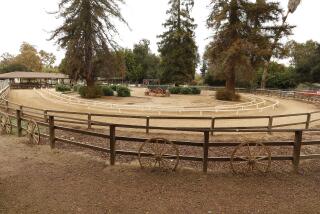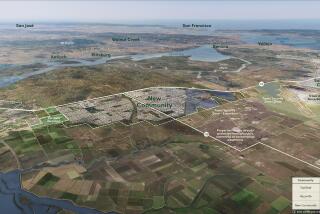14,000 Letters Oppose Plan to Build Houses at Renaissance Faire Site
Opponents of a planned housing development on the site of the Renaissance Pleasure Faire in Agoura on Thursday delivered 14,000 handwritten letters to the Los Angeles County Board of Supervisors, urging the supervisors to deny permits for the project.
After they found that Supervisor Mike Antonovich, who represents the area, was out of town and unable to accept the letters, representatives of homeowners groups and supporters of the annual Elizabethan-style event vowed to read the letters aloud on the steps of the county building in downtown Los Angeles through Saturday.
“The Board of Supervisors is holding the land hostage for the developers,” said Susan Nelson, president of Friends of the Santa Monica Mountains, a conservation group. “If this permit is approved, every other developer will want one, and our canyons will be destroyed.”
Letters Collected
About a dozen people, some dressed in Renaissance-style clothing, unloaded 50 plastic bags full of letters they had collected from opponents of the planned development.
The 320-acre tract of rolling hills and oak trees has been home to the Pleasure Faire for 24 years. For six consecutive weekends each summer, the area has been transformed into a 16th-Century English village, complete with minstrels, artisans and mock royal processions. About 200,000 people attended each year, fair officials said.
But early this year, the owner of the Agoura property, Art Whizin, told members of the fair he would act on his long-time goal of developing the land.
In April, the Los Angeles County Planning Commission voted to recommend that zoning in the area of the fair be changed to accommodate the housing development, a decision that must be reviewed by the Board of Supervisors before becoming final.
Organizers Informed
Stanley R. Romain, who represents Whizin and his partner, Brian Heller, said the fair’s organizers were informed when they renewed their lease in February that this summer would be the last. About 160 single-family homes are planned for the site, Romain said.
On Aug. 4, two months after the fair closed, the developers’ bulldozers razed about 50 fair structures, including stages, stands and booths. Fair supporters have criticized the action, saying they were not given adequate notice.
Meanwhile, conservation groups and the National Park Service, which owns land next to the fair site, have been looking for ways to buy the site, said Daniel R. Kuehn, superintendent of the Santa Monica Mountains National Recreation Area.
Kuehn said his agency was encouraged by a recent U.S. Senate committee decision to appropriate $11 million to buy parkland in the Santa Monica Mountains area. If President Reagan signs this bill, much of that money could be used toward the purchase of the Whizin property, which has been valued at about $14 million, Kuehn said.
‘Unique Chance’
In one of the letters read Thursday, Santa Fe Springs resident Sean Walsh wrote, “I have grown up in Los Angeles and feel this land is a unique chance for people of all ages, nationalities and creeds to indulge in pure fun. I would someday like to bring my children.”
“We are not only losing the fair,” said Jack Albee, who has been performing as a greeter at the site for 25 years. “We are also losing oaks and land and an emotional center through which I and thousands of others can express ourselves.”
Albee, who wore a feathered cap and a medieval-style tunic for Thursday’s demonstration, added: “The energy of the 1960s was the springboard for the fair. In the 1980s, everybody has turned inside of themselves and have become robots for personal gain.”
Representatives of the fair said that if the site is approved for construction, they will move on, reluctantly.
“We will mourn for a period of time and then have to find another place, but it will be nowhere near as magical,” said Kevin Patterson of the Living History Center, the Northern California-based group that stages historical fairs throughout the state.
“Nowhere else in L.A County that we know of are there oak trees that were alive when Queen Elizabeth was alive. The property itself is living history.”
More to Read
Sign up for Essential California
The most important California stories and recommendations in your inbox every morning.
You may occasionally receive promotional content from the Los Angeles Times.










